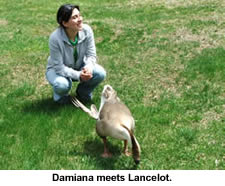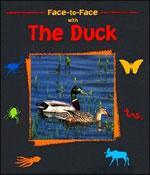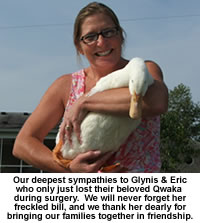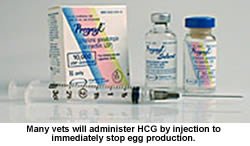Metal Detector
Donation
Majestic extends an enormous THANK YOU to Jean for donating her
retired metal detector to us. It has already proven invaluable
in keeping our construction areas clear of hazards. Thank you to
Chris for hand delivering it to us along with some other
goodies—including stamps. It was great seeing you again!
A Special Thanks!
Majestic would like to
recognize Damiana and Alice for all of their fundraising efforts
over the past year and a half. Through two butter braid sales
and one flower bulb sale, they have raised nearly $900 for our
sanctuary! As if that wasn’t enough, they have also adopted a
few ducks from us and provided them with a wonderful new home.
Thank you for your generosity and thoughtfulness -- you are
amazing!

Fowl Weather
Auction Results
 Thank
you to Bob Tarte and everyone who participated in our “Fowl
Weather” auction fundraiser. We raised $365 towards the
expansion of our sanctuary! Thank
you to Bob Tarte and everyone who participated in our “Fowl
Weather” auction fundraiser. We raised $365 towards the
expansion of our sanctuary!
Get to Know
Your Predators:
American
Alligator

We
just received an email about some domestic geese down south running
into this predator, so we decided to feature the alligator this
month in consideration of our Southern friends.
If you live in a
state where alligators are present (especially Florida and
Louisiana), keep a close eye on any open water that your waterfowl
are frequenting. You especially don’t want your flock out on the
water during evening hours when alligators are most active, so if
there is any chance that an alligator could have slipped into your
pond without your knowledge, be sure that you call your flock off of
the water well before sunset every day -- being mindful not to
release them out again until well after sunrise the following
morning. It is highly advised that you fence in your flock’s
swimming water to keep these visiting reptiles out.
Recommended
Reading*

|
Ordering
information
|
Face-to-Face
with the Duck
By Pascale
Hedelin
Face-To-Face With The
Duck by Pascale Hedelin is an informative picture book for young
readers about the ecology and life cycle of ducks.
Illustrated
throughout with sharp color photographs by the Colibri Agency,
Face-To-Face With The Duck teaches young people about the marsh
that is the duck's natural habitat, their feeding and migration
habits, the phases of a duckling from egg to adult, the hazards
ducks face from hunters to habitat destruction to lead poisoning
from ingesting spent hunting cartridges, cousins of the duck, and
much more.
An excellent
introduction to a common yet hardy and fascinating waterfowl,
especially recommended for children who want to learn more about
their local feathered friends.
|
* |
For
our full recommended reading list, click
here. If you order from
Amazon by way of our website, Majestic receives a
portion of the proceeds!
|
Reader Poll
#29 (2 Parter!)
Question 1:
If you could only have one duck on a desert island as
a companion, which kind would you choose?
Question 2:
If you could only have one goose on a desert island
as a companion, which kind would you choose?
Results of Reader Poll #28
Question:
Now that Wolfgang Puck has gone cruelty-free and banned
foie gras, will you purchase his products and eat at his
restaurants?
|
Yes |
50% |
|
No |
33% |
|
Undecided |
17% |
|
|
|
Contact Us
Majestic Waterfowl
Sanctuary
17 Barker Road
Lebanon, CT 06249
directorATmajesticwaterfowl.org
Our Newsletter
The Majestic Monthly is published 12 times per year.
Previous issues are available in our
Archives.
|
Oviduct Prolapse
A number of people have contacted us recently with egg-laying
concerns. There is not a lot of information available regarding
these serious medical issues, so we’ve decided to compile what
we know for everyone. This compilation is gathered actual first
hand experiences and from conversations and multiple certified vets. Thank you to everyone who helped us
gather so much information so quickly, so that we could share it
with others. We wish you and your flocks well through your
recoveries. -- Kimberly Link
Sometimes when a hen is laying her egg,
her oviduct (internal egg laying tube) comes outside of her
body. This can range from the tip just poking out to the entire
oviduct falling out. Immediate vet care is needed when this happens. Remove the
hen from the company of other ducks to avoid them injuring the
oviduct. Do not attempt to push the tube back into their body
yourself. Keep the oviduct clean and moist until you get to the
vet. A small amount of KY Jelly is a good item to have in your
waterfowl medicine cabinet. It can be placed on the protruding
tissue to keep it moist. Sprinkle sugar on the oviduct to take
down the swelling. This helps the vet when it's time for them to
push the organ back in. Wrap your duck in a towel to prevent
your hen from poking at her own injury.
Your hen will need surgery to stitch the
oviduct back into place. Sutures need to be tight enough to hold
the oviduct in place, but they should in no way prevent normal
egg-laying. The egg must be able to pass through the oviduct
normally.
Once an oviduct prolapse occurs, it will
most likely happen again as normal egg-laying continues. In
order to prevent this, there are two courses of action that can
be taken: injections to prevent egg-laying or a
Salpingohysterectomy.

Salpingitis
Salpingitis is the inflammation of the oviduct (the upper
reproductive tract). The oviduct becomes lined with pus filled
cysts that are often brought on by infection—commonly E.
coli. As with egg binding, it is more common among
overweight or malnourished hens, or among hens who are pushed to
lay excessively utilizing laying formulas.
Hens suffering from Salpingitis often pant excessively and have
a routinely difficult time passing their eggs. This makes it
extremely easy for a misdiagnosis. As with egg binding, hens
with Salpingitis may also exhibit lethargy. Other symptoms
include: redness or swelling around the cloaca, discharge or
odd-shaped, malformed eggs. Sometimes the hen’s abdomen may
actually appear enlarged or she may even experience weight loss,
but many hens show neither of these traits, hiding their
affliction.
If your hen is exhibiting abnormal panting or stress during
egg-laying, seek vet assistance immediately. Vets will commonly
do an x-ray to get a closer look and then advise a
salpingohysterectomy to remove the infected oviduct as no other
treatment is effective.

Metritis
Metritis
refers to the inflammation of the lower reproductive
tract (the uterine portion of the oviduct). It can be brought on
by a systemic (bacterial) infection or by damage caused by egg
binding or peritonitis. Visible symptoms of Metritis and
Salpingitis are the same.
Metritis can
effect contractions during egg-laying as well as having a
negative impact on actual shell formation.
A
salpingohysterectomy to remove
the infected oviduct is commonly recommended.
Peritonitis
Sometimes
when a hen is egg bound (especially when multiple eggs are
trapped in the oviduct) egg components can move incorrectly
through her body and end up deposited in her abdomen.
Peritonitis is more common in overweight hens, those with a
genetic predisposition and among those who lay eggs
excessively—commonly brought on by over-mating or excessive
quantities of laying formulas.
Symptoms of
Peritonitis mimic other aforementioned reproductive ailments,
except that you may also witness yolk colored droppings. An
immediate trip to the vet is in order and an x-ray needs to be
done.
If an egg
has slipped into the abdominal cavity, immediate surgery will be
required to remove the egg and clean out the cavity. Post
operative care includes: antibiotics,
tube feeding and often fluid injections to prevent dehydration.
Because there is a risk of reoccurrence, many vets will
advise continual injections to prevent egg-laying or a salpingohysterectomy
as a means of preventative treatment.
By knowing the personality and habits of
your duck or goose, you prepare yourself for noticing
abnormalities in their behavior. Always call your vet at the
onset of symptoms or behavioral changes. Ducks and geese mask
their symptoms well as a predatory defense, so early detection
is vital to successful treatment.

Injections
Two common vet choices to temporary halt
a hen’s egg-laying are Human Chorionic Gonadotropin (HCG) or
Luperon (Lupron®).
HCG causes regression of the ovarian
follicles and, therefore, inhibits ovulation. The benefit of
this drug is that it works quickly and has few side effects if
used for short periods of time. This drug is an option for first
time/one-off incidents. Three treatments are often given at 48
hour intervals. Long term side effects may include ovarian
tumors, so it is only recommended for intermittent use.

The most widely used hormone therapy
being utilized at present time to stop the egg-laying cycle is
Leuprolide or Lupron®. Administration inhibits gonadotropin
secretion and suppression of ovarian hormone production, which
brings a stop to egg production. Side effects, if experienced at
all, are minimal, so it is considered to be very safe. One
problem with Lupron® is it may up to several weeks to begin
taking effect. It seems to have the greatest effect on those
hens who have only been laying for a short period of time. This
time delay can be a real issue if your hen needs an immediate
break from her daily egg-laying routine. In addition, some
ducks/geese become immune to the treatment within a short period
of time, making it only a temporary solution.
Many vets will administer HCG to
immediately stop egg production in addition to a Lupron® shot
for a longer lasting effect. A shot of Lupron® may be repeated
about every three weeks, if a longer break in laying is
required. Combined together these two therapies are an excellent
way of preventing egg-laying during the waiting period before a
Salpingohysterectomy can be performed.

If you have utilized either of these therapies, please email us
at
directorATmajesticwaterfowl.org
and let us know how they worked for your hen, so we can share
your information with others.
Salpingohysterectomy
The only permanent solution to put a
stop to Chronic Egg-Laying and to guarantee the prevention of
further Oviduct Prolapse or Peritonitis incidents is through
surgery. The procedure in which the left oviduct (the
functioning oviduct) is removed is known as a
Salpingohysterectomy.
An abdominal incision is made and the
left oviduct is removed. The operating vet should inspect the
vestigial right oviduct to verify that it truly is
non-functioning. There have been rare instances of the right
oviduct being operative and functional; if so, it will need to
be removed as well. Refer to our
September 2006 newsletter
for a diagram of the oviduct. The ovary is not normally removed
because it can be difficult to reach and can bleed heavily,
resulting in hemorrhaging.
A Salpingohysterectomy is often left as
a last resort because it is a complicated, risky and costly
procedure, but it is commonly necessary to prevent reoccurring
and life-threatening medical issues. It can be especially risky
if your hen is still recovering from prior surgery. Be sure to
research this option thoroughly with your experienced and
certified waterfowl vet before making a decision.
Confirm your vet of choice has performed
this surgery successfully before on ducks/geese—not just on
birds (parrots, etc.). Ask them about their surgical and
post-operative experience, mortality rates, anesthesia risks,
pain-killers, antibiotics, post-surgical care requirements and
expense. Be sure to inquire about after-hours and weekend
emergency situations. Plan out your options in advance should
your vet be unavailable during these times. You may need a back
up vet who is fully versed in the situation and can assist you
and your hen post-surgically if your vet is unavailable.
|

